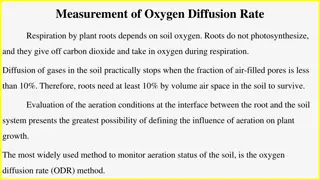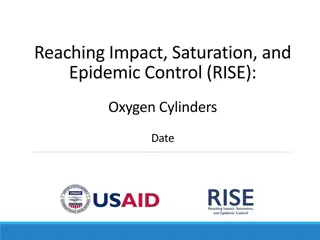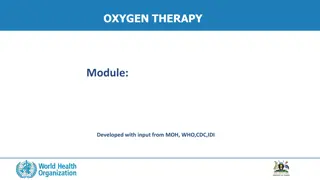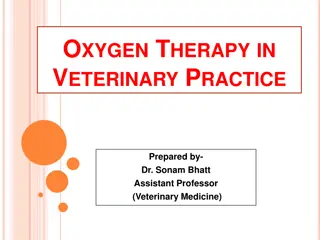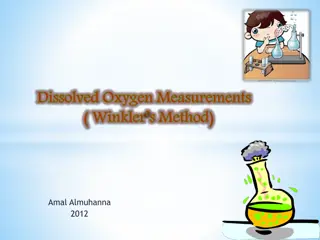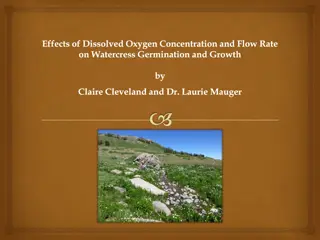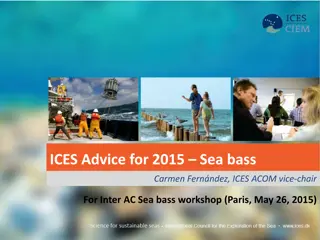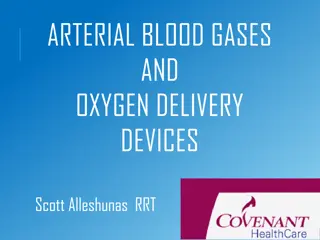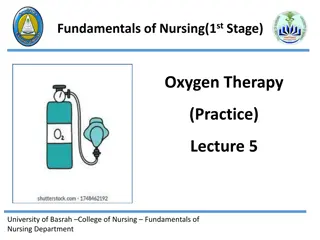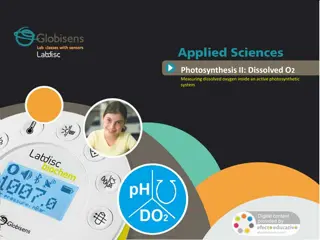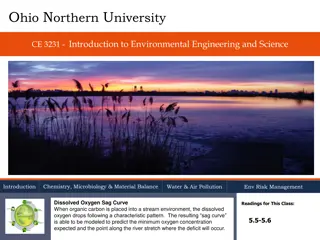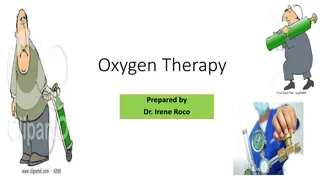Maintaining Dissolved Oxygen Levels for Black Bass in Livewells
Dissolved oxygen is crucial for the health of black bass in livewells, especially during warmer months. This presentation explores the importance of oxygen equipment to maintain sufficient oxygen levels, recommends system components, and provides guidelines for installation, operation, and safety measures. Industrial oxygen regulators are discussed, highlighting the importance of proper storage and handling. Important considerations include oxygen depletion, oxygen levels for stress and lethality, and safe practices for using oxygen equipment on recreational fishing boats.
Download Presentation

Please find below an Image/Link to download the presentation.
The content on the website is provided AS IS for your information and personal use only. It may not be sold, licensed, or shared on other websites without obtaining consent from the author. Download presentation by click this link. If you encounter any issues during the download, it is possible that the publisher has removed the file from their server.
E N D
Presentation Transcript
Texas Parks and Wildlife Department Inland Fisheries Division (updated 03/13/2024)
Dissolved oxygen is the most critical factor for maintaining health of black bass retained in livewells. Various oxygen equipment was tested to determine a simple, effective, affordable, and safe system for maintaining sufficient dissolved oxygen in livewells (> 7.0 ppm). This presentation recommends system components and describes installation, operation, and safety. Complete oxygen injection system
During warmer months, potential oxygen depletion in livewells is rapid with no recirculation or oxygenation. With factory recirculation pumps, not possible to maintain sufficient oxygen levels with heavier weights at warmer water temperatures. Oxygen Levels Sufficient - > 7.0 ppm Stressful - < 5.0 ppm Lethal - < 2.0 ppm At extreme conditions, oxygen injection (0.25 LPM of flow) maintained oxygen at 14 to 22 ppm over nine hours.
Industrial Oxygen Regulator Industrial grade and not considered a medical device by FDA or Texas Department of State Health Services. CGA540 inlet and barb outlet. PSI gauge which indicates fullness of oxygen bottle. Adjustable flow, set to 0.25 LPM (1/4 LPM).
Size Diameter (inches) Length including valve (inches) Total hours of use at 0.25 LPM and 4-inch diffusers classification Capacity 15 ft3 9 ft3 MD or D M9 or C 4.4 4.4 20 14.2 35 20 Use of a CGA540 valve permits use and refill with welding (industrial) grade oxygen. Use of medical grade oxygen is by prescription only. Bottle top will often be painted red by oxygen supplier to indicate its filled with welding grade oxygen.
Securely store or mount bottle protecting it and the regulator from impact and excessive vibration. Consider different bottles sizes when choosing mounting location. Do not locate bottle in boat bilge or in compartments containing oil, gas, or batteries. Remove oxygen bottle from boat when not planning to use. 9 ft3 bottle mounted in wood box in compartment under seat 5 lb. fire extinguisher bracket and large hose clamps 9 ft3 bottle mounted with fire extinguisher bracket in compartment under seat 15 ft3 bottle mounted with fire extinguisher bracket under console
There are no federal or Texas regulations specific to use and storage of oxygen equipment on recreational fishing boats. Aluminum bottles require re-testing every 5 years Oxygen by itself is not flammable, however the pure form is a dangerous accelerant and highly reactive to oil-based products. Do not smoke around oxygen equipment Do not use products containing oil on or around oxygen equipment (e.g. WD-40, silicone, etc.) or combustion of these may occur Test all connections with soapy water to ensure there are no oxygen leaks before use. Cable/zip ties were inadequate Use hose clamps or more secure connectors Frequently re-check hoses and connections for leaks and damage Do not fill oxygen bottle from another bottle (i.e. transfill). Bottle or valve failure could result.
Most bass boats have two independent livewells. The single oxygen line from the regulator is split to form two lines to facilitate oxygen injection into both livewells. This tee connection should be made as as near as possible to where oxygen line will be routed thru the rear wall of the livewells. 1/4 barbed tee livewell 2 livewell 1 ID oxygen-rated hose should be used between the regulator and livewell. regulator The hoses running from the tee to the oxygen diffusers should be equal length.
Route hoses from tee fitting through upper rear livewell wall to oxygen diffusers
Operation Oxygen injection and recirculation pumps recommended when water temperatures exceed 75 F. Running recirculation pumps is required with oxygen injection to prevent carbon dioxide from reaching stressful levels. Running pumps diffuses most carbon dioxide out of the livewell water. Turn the knob counterclockwise on the CGA540 valve to inject oxygen. Set flow knob on regulator to 0.25 LPM (1/4). Diffusers will take 3-4 minutes to pressurize before producing oxygen bubbles. Both livewells must be filled with water for diffusers to function properly. If one livewell is filled and the other left empty, all oxygen will flow out the diffuser in the livewell having no water due to path of least resistance. The surface of the diffusers can be cleaned using 60-grit sandpaper if dirt or build-up hamper performance.
Safety should be the primary concern if modifying system or substituting components. Lower quality diffusers are much less efficient and will not achieve desired oxygen level at the recommended oxygen injection rate of 0.25 LPM.
Overall Livewell Management More information on livewell oxygen injection https://tpwd.texas.gov/fishboat/fish/recreational/catchrelease/livewell.phtml Other proven livewell management techniques B.A.S.S. publication Keeping Bass Alive Cooling the water Addition of stock salt (unionized) https://www.bassmaster.com/wp-content/uploads/2022/04/keepingbassalive_guidebook_comp.pdf Fizzing http://www.tpwd.state.tx.us/newsmedia/releases/?req=20110202d
Component, Cost, and Supplier List Item Aluminum Oxygen Bottle 15 ft3 capacity (MD) with standard CGA540 valve Part Number Cost Supplier 15CUFTALVLV-5LBEQ-540 $85 Gas Cylinder Source gascylindersource.com 866-395-5049 or local gas company Industrial Oxygen Regulator CGA540 inlet, 1/4" barb outlet, capable of 0.25 LPM flow 540 Industrial Regulator, 0- 4 LPM $77 Simply O3 Simplyo3.com 844-655-2524 Oxygen Fill Welding grade oxygen $15 Local Gas Supplier Bottle Mounting Bracket Hallmann Sales Larsen s 5-lb fire extinguisher bracket 821 $29 hallmann-sales.com (866) 966-9596 Diffusers, Fittings, Tubing, and Clamps 2 - Sweetwater Micro Bubble Oxygen Diffusers 4 x 2.5 diffusing area DYPFP4 $92/pair Pentair Aquatic Eco-systems pentairaes.com 877-347-4788 OX4F 62064 SSI SSAA $2/ft. $1 $6 $8 ID green oxygen hose tee (barb) connector 2 - 4 hose clamps for fire ext. bracket 6 - stainless steel hose clamps Costs do not include shipping or tax and prices are subject to change. Equivalent items are available from other vendors.
We thank the following for their assistance and comments: Aquatic Ecosystems AirGas Matheson Tri-Gas Coastal Gas James and Tom Bendele (Falcon Lake Tackle) Ken Parker (Boerne Marine) Rick Pierce (Bass Cat Boats) Gary Clouse (Phoenix Boats) Gene Gilliland (Oklahoma Department of Wildlife Conservation) Hal Schramm (Mississippi State University) Carl Wengenroth (Angler s Lodge) TPWD-Inland Fisheries Randy Myers Jason Driscoll Todd Driscoll Todd.Driscoll@tpwd.Texas.gov 409-698-9114



